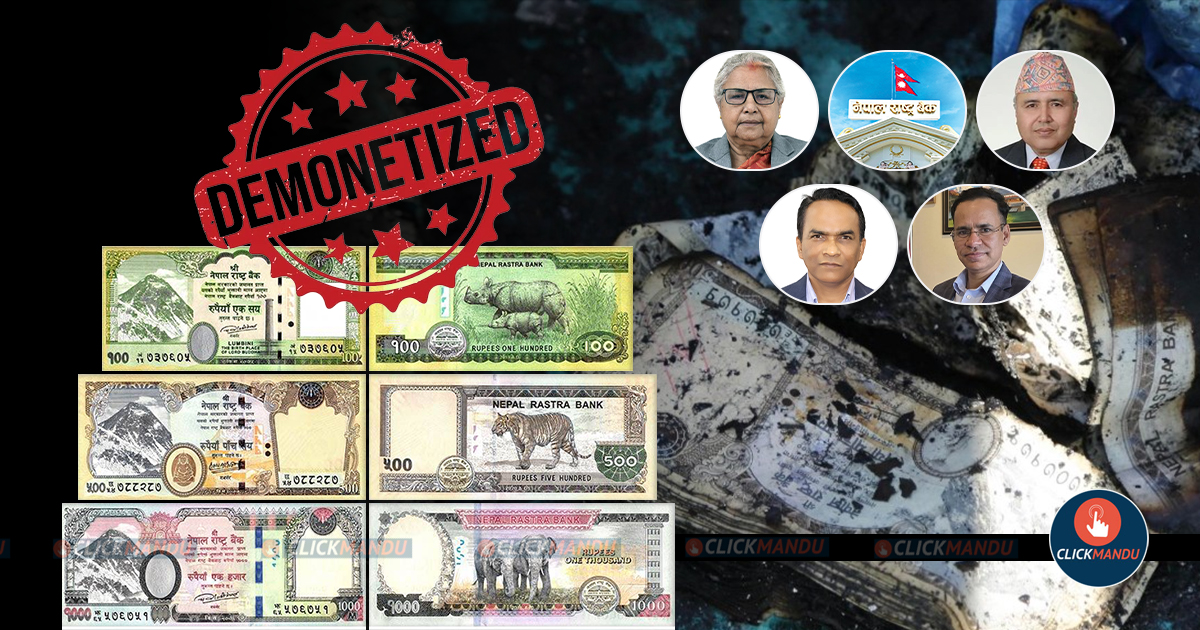Kathmandu: The Gen-Z protests and the wave of arson, looting, and vandalism that followed have reignited debate on demonetization in Nepal, after huge stacks of currency were discovered in the homes of top political leaders. Millions of rupees were either burned to ashes or looted by protesters, reinforcing public suspicions that politicians had been hoarding illicit wealth.
Outraged citizens quickly turned to social media, demanding an immediate ban on high-denomination banknotes. Calls for scrapping Rs 500 and Rs 1,000 notes—before the upcoming elections—flooded online platforms. Former finance secretary and economist Rameshore Khanal was among those urging to push for swift demonetization.
Cash hoarding is widely seen as a vehicle for corruption, tax evasion, and money laundering. While Nepal’s law restricts individuals from holding more than Rs 1 million in cash, enforcement has been weak. The sight of politicians’ homes stuffed with bundles of notes has fueled demands for decisive action to flush out “black money.”
Demonetization—or amaudrikikaran in Nepali—is the process by which a government or central bank declares certain banknotes invalid for circulation. From the next day of such a declaration, the targeted notes lose their legal status, forcing holders to deposit them in banks or risk losing their value entirely.
Nepal Rastra Bank defines it as withdrawing a currency denomination from circulation after a set date so that it is no longer legally recognized as tender. Its aims include curbing black money, preventing counterfeit currency, promoting digital transactions, increasing tax compliance, and controlling inflation.
Countries worldwide have used demonetization as a tool to combat corruption and illegal financial flows. India’s sudden 2016 ban on Rs 500 and Rs 1,000 notes remains the most cited example. Though it pushed millions into long queues at banks, it helped bring more income under the tax net—even if its impact on black money remains disputed. Other countries, from Nigeria to Pakistan, North Korea to Zimbabwe, have carried out similar measures, often with mixed results.
The issue has grown louder after cash-filled secret vaults were allegedly found at the residences of former Prime Minister Sher Bahadur Deuba, Maoist chairman Pushpa Kamal Dahal ‘Prachanda,’ and Energy Minister Deepak Khadka. Viral videos and photos of scorched or looted banknotes have deepened mistrust of the political elite.
Data from Nepal Rastra Bank adds weight to the debate: as of mid-July, over Rs 656 billion in cash was circulating outside the banking system, with a sharp increase of Rs 78 billion in just one year. This raises questions about unaccounted wealth hidden from the financial system.
Advocates argue that demonetization could prevent illicit funds from being used in the upcoming February 21 parliamentary elections, while also helping Nepal exit the Financial Action Task Force’s “grey list” on money laundering.
Yet, the policy is not without dangers. Past experiences in India, Ghana, and Nigeria show that demonetization can hurt ordinary citizens, particularly in rural areas with limited access to banking and digital payments. Critics warn that a poorly planned move could wipe out savings of the poor while leaving the corrupt largely unscathed if they receive advance notice.
With public anger against corruption at a peak, many see demonetization as an “instant cure.” Social media users are calling it the only way to neutralize illicit funds hidden under beds, in water tanks, or underground bunkers. While Finance Ministry officials remain cautious, the mounting demand from citizens, activists, and even some politicians suggests the issue may soon climb to the top of the policy agenda.
For the Gen-Z generation, which is driving the current wave of political change, demonetization has become more than an economic debate—it symbolizes a demand for accountability and a break from decades of entrenched corruption.



Comment Here